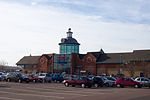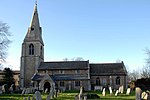Yaxley and Farcet railway station
Disused railway stations in CambridgeshireEast of England railway station stubsFormer Great Northern Railway stationsPages with no open date in Infobox stationRailway stations in Great Britain closed in 1959 ... and 3 more
Railway stations in Great Britain opened in 1890Use British English from December 2016Yaxley, Cambridgeshire

Yaxley and Farcet railway station is a former station in Yaxley, Cambridgeshire, just south of Peterborough.
Excerpt from the Wikipedia article Yaxley and Farcet railway station (License: CC BY-SA 3.0, Authors, Images).Yaxley and Farcet railway station
Station Road, Huntingdonshire Yaxley
Geographical coordinates (GPS) Address Nearby Places Show on map
Geographical coordinates (GPS)
| Latitude | Longitude |
|---|---|
| N 52.5217 ° | E -0.2416 ° |
Address
Station Road
Station Road
PE7 3EW Huntingdonshire, Yaxley
England, United Kingdom
Open on Google Maps








